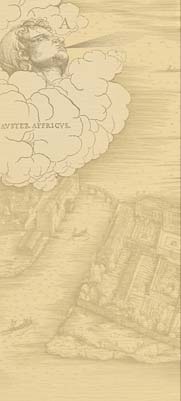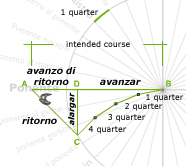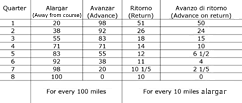Navigation: Toolkit
Multiple Course Changes
A sailor would be lucky to make only two course changes on a voyage. Normally, he would have to tack back and forth several times to make any progress. Michael shows how to use the marteloio to recover a course after making multiple tacks or being blown off course in several directions.
As he states the problem (![]() 48a):
48a):
"I want to sail by ponente, but I sail 100 miles ponente al garbin, 100 miles ponente garbin, 100 miles garbin al ponente, and 100 miles garbin. How many miles must I sail by maistro to recover my course, and how much would I have advanced when I got there?"
For this problem, it is helpful to note that the quarter of ponente al garbin (west by south) is 1 quarter off the intended course; ponente garbin (west southwest) is 2 quarters; the quarter of garbin al ponente (southwest by west) is 3 quarters; and garbin is 4 quarters. Maistro (northwest) is also 4 quarters off the intended course.
-
a) The ritorno
Michael's first task is to calculate the ritorno (CB). He has a rule for this that uses values from the marteloio table.

To get the total alargar for the formula, he simply adds the alargar for each wind together, then proceeds as usual.
To make the calculation:
-
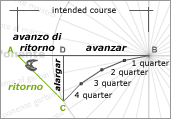
1] Michael takes the values he needs from the table. Since he sailed 100 miles on each of his first four headings, he adds these values together:
20 + 38 + 55 + 71 = 184
So his total alargar is 184. The ritorno for the second wind (CA) of 4 quarters is 14.
-
2] Michael now calculates the ritorno:

He will have to sail 257
 miles by maistro to get back to his intended course.
miles by maistro to get back to his intended course.
-
-
b) The avanzar
Michael's second goal is to calculate how far he would have advanced toward the destination by the time he recovered his course. This means he has to add the avanzar (BD) to the avanzo di ritorno (DA).
He has already explained his rule for calculating the avanzo di ritorno.

To make the calculation:
-
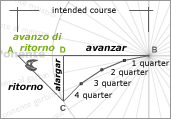
1] Michael knows the alargar for the first part of his journey (BC) is 184. He takes the value for the avanzo di ritorno for the second part of his journey by maistro from the table. The value is 10.
-
2] Michael now calculates the actual avanzo di ritorno:

He would have advanced 184 miles on the second part of his journey.
-
3] Michael calculates his initial avanzar. Since he traveled 100 miles on each of the first four legs of his journey, he can simply take the value for each wind from the table and add them together:
98 + 92 + 83 + 71 = 344
-
4] Michael must now add the avanzar to the avanzo di ritorno:
344 + 184 = 528
So Michael will have traveled 528 miles toward his destination by the time he recovers his course.
Note that if Michael had traveled distances other than 100 miles on the first four legs of his journey, he could easily find the alargar and avanzar for each leg using the rule of three.
-
See how Michael recovers a course or plots a course in advance.











